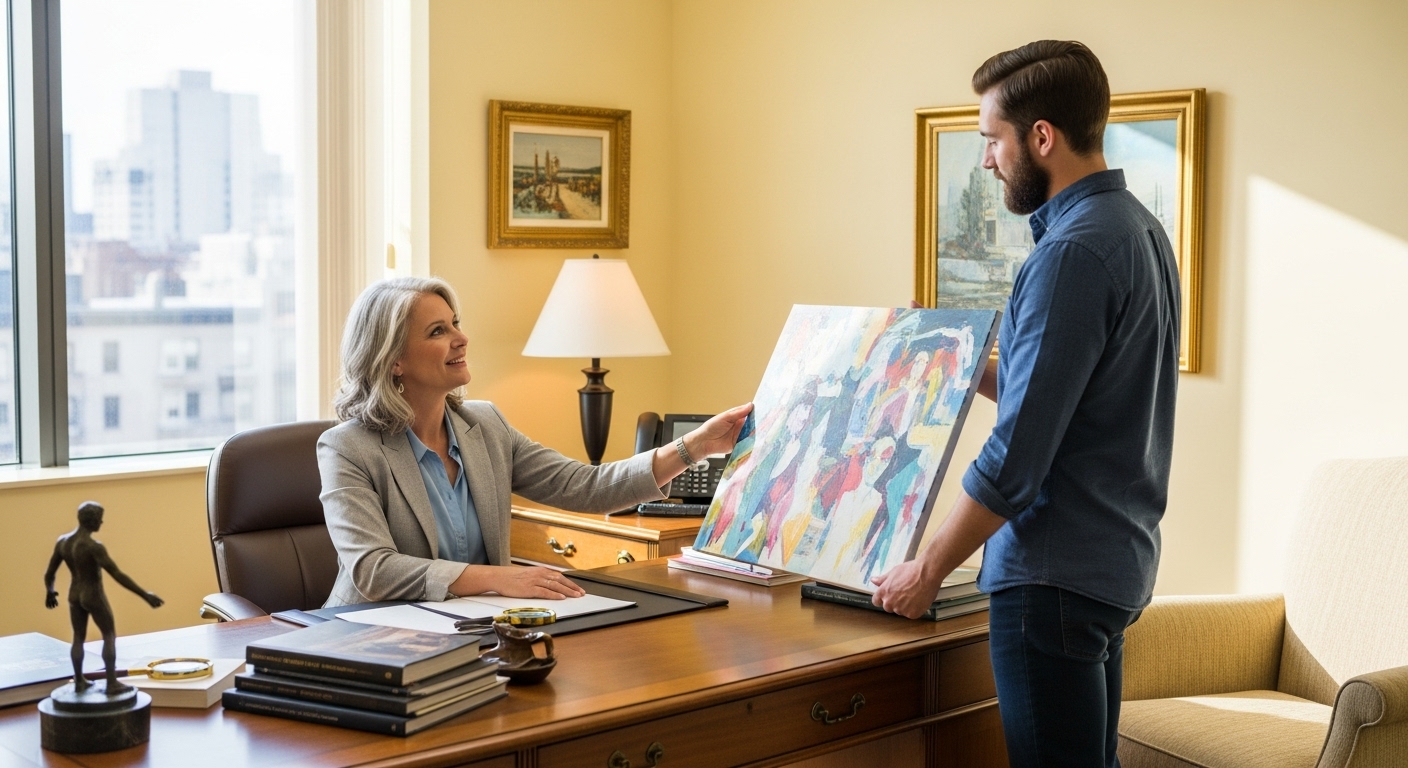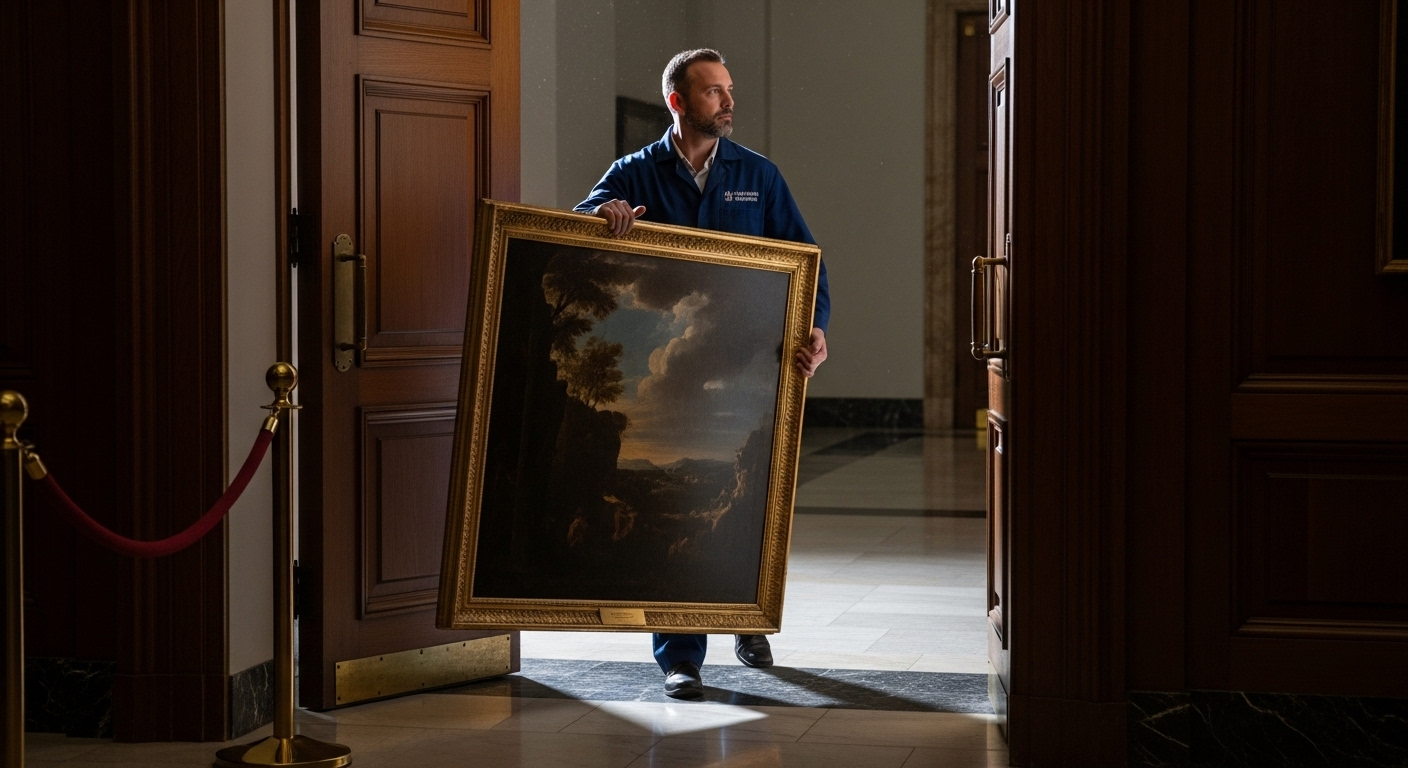What Counts as Cultural Property: A Plain-Language Guide

When it comes to exporting paintings from Ukraine, many owners encounter the term “cultural property.” The phrase often sounds official and a bit intimidating — especially if it’s a person’s first time sending an artwork abroad. Yet understanding what actually qualifies as cultural property helps you avoid mistakes, customs delays, and unpleasant surprises.
It’s important to remember: not every painting or sculpture is automatically cultural property. But this very classification determines whether you need an examination, an official export permit from Ukraine, and the follow-up customs paperwork.
ArtDom helps artists, collectors, and galleries navigate these nuances: determine whether a work qualifies as cultural property, prepare documents, and complete the examination process without bureaucratic hassle.
What “Cultural Property” Means Under the Law
To understand what counts as cultural property, let’s look at the legislation. Under the Law of Ukraine “On Export, Import and Return of Cultural Property,” cultural property is any item that has historical, artistic, scientific, or cultural significance and is protected by the state.
Such items include:
- works of painting, sculpture, graphics, and decorative art;
- historic icons and religious objects;
- antiques — household items, furniture, jewelry over 50 years old;
- archival documents, manuscripts, maps, photographs, books;
- unique objects connected to historical events or notable persons.
In other words, cultural property is not just an old object; it is something that matters to history, science, or art and reflects the cultural heritage of a people.
Not All Art Is Cultural Property
Many owners mistakenly think any painted work automatically meets the definition of cultural property. That’s not the case.
Contemporary paintings, decorative panels, reproductions, prints, and even original works by young artists are not considered cultural property unless they have historical or public significance.
For example:
- a painting created by a contemporary artist in 2024 is unlikely to be recognized as cultural property;
- but a canvas from the late 19th century — even by an unknown author — may be classified as a protected cultural object.
The key criteria are age and significance for art history. That’s why, before exporting paintings or icons abroad, it’s crucial to check whether an examination and a permit are required.
Why Defining Cultural Status Matters
Whether your piece is cultural property directly affects your ability to export it from Ukraine.
- If a work does not show signs of cultural value, you can export it freely, though it’s advisable to have an expert report on paintings, art, and fine arts confirming that the object is not subject to state control.
- If experts determine that the painting is cultural property, you will need an official export permit from Ukraine.
A wrong assessment often causes customs delays: officers have the right to stop export if there are no documents confirming status.
When an Export Permit Is Mandatory
Obtaining a permit is required if:
- Age exceeds 50 years. Even if it’s not a museum piece, anything created more than half a century ago is subject to verification.
- Artistic and historical value. If a painting, icon, or sculpture is in a unique technique, bears the signature of a renowned artist, or is significant for art — export is allowed only with a permit.
- Originals by well-known authors. Even relatively “young” works (e.g., from the 1970s–1980s) by notable artists require examination and control.
- Hand-made icons and sculptures. These often require an expert report due to potential spiritual or historical significance.
ArtDom helps owners determine the category of the object and, if necessary, obtain an export permit promptly.
How the Cultural-Value Examination Is Conducted
An examination evaluates an artwork and determines whether it qualifies as cultural property. It is performed by accredited experts of the Ministry of Culture of Ukraine and consists of several stages.
1. Inspection and Description
The expert visually examines the work and records:
- dimensions and format;
- material (canvas, wood, paper, metal, stone, etc.);
- technique (oil, watercolor, modeling, carving);
- surface condition and any restorations.
This becomes part of the expert report on paintings, art, and fine arts.
2. Analysis of Age and Technique
Specialists determine the time of creation — visually or using lab methods:
- analysis of paint layers, varnish, canvas;
- spectral analysis of pigments;
- microscopic study of fibers.
This step is especially important for export of paintings and icons, to confirm the piece is not antique.
3. Assessing Artistic and Historical Significance
The expert evaluates artistic level, originality, and historical context.
If the painting or sculpture shows signs of significance — unique technique, rare style, signature of a notable author — it may be recognized as cultural property.
Otherwise, the expert states that the work does not have signs of cultural heritage and may be exported without restrictions.
4. Expert Report
The result is an official expert report indicating:
- description of the work;
- conclusion on authenticity;
- date of creation and author;
- assessment of cultural and historical value.
If the work is not recognized as cultural property, you can send the painting abroad from Ukraine without additional permits.
If it is recognized, you must obtain an export permit from the Ministry of Culture.

Center for packaging valuable and fragile items in Ukraine – https://packingcentre.com.ua/
What to Do If the Work Is Recognized as Cultural Property
If the examination shows your object truly has cultural value, this does not mean you cannot export it — the procedure is just more complex. You need to:
- submit an application to the Ministry of Culture of Ukraine;
- attach the expert report and photos;
- wait for processing (usually 10–15 business days);
- obtain the permit presented at customs when exporting the painting from Ukraine.
ArtDom supports clients at every step — from filing the application to obtaining the permit. We ensure correct paperwork and careful handling of the artwork.
Tip: keep a copy of the expert report during transportation. Customs may request it even upon re-import after an exhibition.
What Is Not Valuable to the State but Valuable to the Artist
Not all works fit the definition of cultural property. That doesn’t mean they lack personal or market value.
For instance:
- contemporary paintings created recently;
- decorative compositions and interior art;
- prints, reproductions, posters;
- study pieces or copies.
For such objects, an examination may still be useful to confirm that export of the painting or sculpture does not require a permit.
ArtDom helps determine status and prepare documents even for contemporary works, so there are no questions at the border.
How to Avoid Problems When Exporting Art Abroad
Most issues at customs arise due to missing examinations or incorrect paperwork. To ensure export of paintings from Ukraine goes smoothly:
- Request an examination in advance. Even if you’re sure the work is contemporary, it’s better to have official confirmation.
- Keep authorship documents. Contracts, certificates, invoices, or gallery letters confirm provenance.
- Don’t rely on verbal explanations. Customs accepts only official documents: an expert report or a permit.
- Use professional packaging. Especially for icons and sculptures, where condition is critical.
- Trust professionals. ArtDom specializes in export of paintings, icons, and sculptures, works with experts, and prepares permits quickly and accurately.
Even if a work has no signs of cultural value, having an official report removes extra questions and ensures a smooth export.

Frequently Asked Questions (FAQ)
What counts as cultural property when exporting paintings from Ukraine?
Cultural property is an artwork with historical, artistic, or scientific significance — e.g., old paintings, icons, antiques, archival documents, or unique sculptures. If your work is over 50 years old or by a well-known author, you’ll need an examination and an export permit from Ukraine.
How to send a painting abroad from Ukraine if it isn’t cultural property?
If a painting is not recognized as cultural property, you can export it without restrictions, but it’s still wise to have an expert report on paintings, art, and fine arts confirming it is not subject to state control. This helps avoid customs delays.
Who decides whether a work is cultural property?
Status is determined by accredited experts of the Ministry of Culture of Ukraine. They conduct visual and lab analyses, assess age, technique, and artistic significance, and issue an official report, based on which export is allowed or restricted.
Is an examination required to export icons?
Yes. Export of icons from Ukraine always requires an examination. Even for modern icons, you must document that they lack historical or religious significance. Without a report, customs may detain the shipment. ArtDom will arrange the examination and paperwork.
How to know if an examination is needed for exporting paintings?
If a work is over 50 years old, by a well-known artist, or in a rare technique — an examination is mandatory.
Contemporary paintings generally don’t need a permit, but an expert report is recommended to confirm legal export.
Can sculptures be exported without a permit?
Rules mirror those for paintings. If a sculpture is contemporary and has no signs of cultural value, it can be exported freely with an expert report. Antique or historically significant sculptures require an official permit.
How long do the examination and permit take?
Typically, examination: 3–10 business days, permit: 7–15 days. Timelines depend on complexity and number of items. ArtDom speeds the process by preparing a complete documentation package and working directly with experts.
Can I order an examination remotely?
Yes. Send high-quality photos of the painting, icon, or sculpture and basic details. ArtDom will perform a preliminary review and arrange an official examination with a report, so you can complete export of paintings from Ukraine even without being present.
Why choose ArtDom?
Because we handle everything: the examination; the export permit from Ukraine; packaging, logistics, and insurance; and full support at every step. ArtDom is your reliable partner for exporting paintings, icons, and sculptures abroad — lawfully, accurately, and without stress.
Conclusion
Understanding what constitutes cultural property helps you avoid many bureaucratic and legal issues. Cultural property isn’t just “old” — it’s anything meaningful to history, art, or science.
Correctly determining the status of a painting, icon, or sculpture is the key to successful and legal export of paintings from Ukraine.
ArtDom helps artists, collectors, and galleries complete the examination, obtain an expert report, secure the permit, and safely ship the painting abroad.
If you’re unsure whether your work needs an examination — contact ArtDom. We’ll verify, prepare the documents, and ensure a lawful and reliable export of your artwork.
Call us: +380632478102.
Message us on Telegram or Viber
Reliable packaging and international delivery of valuable items – https://wellpack.com.ua/

